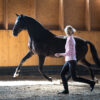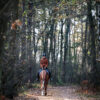Training Young Horses Is a Must
(This is a 5-Minute Read — but the wisdom lasts a lifetime)
“If you think early training will ruin your horse, it’s not the timing that ruins them — it’s the methods.”
The Superstition That Costs Horses Their Future
For decades, many riders and trainers have clung to the belief that a horse should not be trained until the age of 2.5 or even 3 years. The rationale is presented as kindness: “Let them grow,” “They’re too young to work.”
But here’s the staggering inconsistency — once that arbitrary birthday arrives, the very same horse is thrust into an intense, accelerated program to “catch up.” The head is fixed with side reins, the body is driven on the lunge in panicked circles, and a diet of high-fat, high-protein feed — alien to their naturally liver-friendly hay and grass — is suddenly introduced to build muscle overnight.
It’s the equivalent of taking a toddler and expecting them to become a professional athlete in three months. Then, a saddle is strapped on and the horse is “broken in” in a week.
The results are predictable: mental and physical trauma, stress disorders, compromised movement, and a shortened career. These rushed beginnings are the mother and father of most problems we later blame on “difficult” horses — contact issues, spookiness, anxiety, lameness, kissing spines, and even dangerous behavior.
Why Waiting Makes No Sense
Even if riding is delayed until full skeletal maturity, the process of training must begin early — much earlier than most people dare to think.
Left in a field with no structure, young horses develop movement patterns based entirely on fear and excitement. Their locomotion is chaotic, their gaits reactive. They gallop only when startled or chasing another horse, and they have no idea how to consciously shift gaits.
“Pasture movement is reactive; educated movement is creative.”
Educated movement can be initiated at will, from within. It is balanced, controlled, and sustainable. It happens without the need for fear or adrenaline — and that changes everything.
The Foundation: Conscious Relaxation
“Relaxation is not a moment — it’s a state your horse can learn to choose.”
Without autonomic downregulation — the body’s switch from stress to rest — learning simply doesn’t happen. Relaxation can be taught at any age, but the earlier it is installed, the deeper it takes root.
When a horse is truly in Conscious Relaxation, their muscles feel like water-filled silk. The skin glides over the body. The fascia is supple, the connective tissues hydrated. By contrast, a tense horse’s skin feels “shrink-wrapped” to the body — a sign of long-standing stress that has already begun to impair movement and neurological function.
Standing next to such a horse affects you too — your breathing slows, your heart rate drops. People often find themselves yawning, stretching, even fighting the urge to nap.
With young horses, the transformation can be almost instant. Within minutes, a foal can stretch its topline, lie down for the first time near a human, or fall asleep with its head resting in a lap.
The process is deceptively simple: stand quietly in a safe, familiar place, apply the Conscious Relaxation technique, and let the horse spontaneously relax. Over two to three weeks, that spontaneous release becomes a conscious skill — one they can use in any context for the rest of their life.
The Secret Weapon: Tendon-Based Movement
The horse is a tendon-driven organism. In correct locomotion, muscles fire only briefly to preload the tendons, which then recoil and release energy back into the stride. It’s nature’s most efficient design.
Riding a horse in tendon-based movement is like floating on invisible springs. Each step is quiet, light, and full of energy — without the “spark” of fear or adrenaline. The movement becomes self-sustaining, requiring no constant reminders from the rider’s leg or whip.
After a tendon-based session, a horse looks rounder, more muscled, and yet softer. The muscles are fuller but not hard. The footfalls go from loud and pounding to nearly inaudible. The gait feels harmonious, with the whole body moving in one fluid piece.
“Every stride in tendon-based movement is therapy.”
Gazelles, cheetahs, kangaroos, and cats all rely on tendon recoil. Horses sometimes use it naturally in excitement — but when taught to access it in calm, it transforms their athleticism and longevity.
Early Preparation – The First Conversations
With foals, the work begins in conscious relaxation: touching the entire body, giving legs, introducing objects, and learning to follow a halter — not through pressure and release, but through touch and feel.
This isn’t imprinting. There’s no critical 24-hour window, no need for daily drilling. One session done in conscious relaxation can permanently change the horse’s nervous system response.
Foals raised this way have better balance, stronger muscles, and more confidence. They aren’t lazy, they don’t shy away, and they embrace movement without fear.
Preparing for Riding – Building the Dynamic Bridge
By the age of 5 or 6, if prepared correctly, a horse will have the “dynamic bridge” from sacrum to poll: a topline that carries itself, a core that stabilizes the load of a rider from the very first step.
A horse without self-carriage either lags without energy or rushes like a toddler trying not to fall. A horse with self-carriage moves as steadily with a rider as they do in hand.
“The industry loses more horses to poor starting than to any other single cause.”
Starting too early without preparation wastes potential, talent, and lives. Up to 85% of horses fail to make it through commercial starting systems — not because they are “bad” horses, but because the system itself is broken.
When a horse is truly ready, they invite the rider: pausing at the mounting block, sniffing the saddle, showing curiosity. It’s an intuitive readiness, like knowing when someone wants a hug.
The Dual Model – Freedom + Science
Our horses live in stable social groups, moving freely in open pastures, relaxed and curious. The soundtrack is hay being chewed, soft nickers, and the absence of the acrid “stress smell” found in many barns. Relaxed horses have manure so mild it is almost sweet-smelling, and their coats carry the scent of hay and wind.
Training happens 3–4 times a week in short, precise micro-sessions. Relaxation is checked — never assumed. We don’t train “behaviors.” We train the process of entering emotional states like calmness, which can look different each time but follow the same organic pathway.
Tendon-based training even changes free movement: horses in turnout become more uphill, suffer fewer injuries, and maintain muscle tone without daily grind.
The Bigger Perspective
Without conscious relaxation and tendon-based movement, every other training ambition is like building a skyscraper on moving sand — doomed to collapse.
When an owner sees their young horse choose relaxation for the first time, it is often life-changing. Tears are common. In that stillness of being, horse and human meet as they truly are — beyond fear, reactivity, and performance.
From that moment, most owners cannot bring themselves to make harmful choices for their horse. The connection is too deep. And that moment — that recognition in Conscious Relaxation — is the greatest protection a young horse can have.
Practical Tips & Next Steps – Creating the Best Start for Your Young Horse
“Every day you wait to begin the right kind of training is a day your horse is rehearsing the wrong patterns.”
If you want your young horse to grow into a confident, sound, and balanced partner, the journey begins with the very first interactions — and those interactions must be anchored in Conscious Relaxation.
1. Start with Conscious Relaxation — Always
Before any physical training, before leading, before gait transitions — teach your horse how to choose relaxation.
-
A horse that can consciously relax can remain calm and soft 24/7, in any environment.
-
This isn’t about “making” the horse relax; it’s about teaching them to enter that state on their own, so they carry it into every moment of their life.
2. Build a Relationship Through Relaxation
Do things together where your young horse can use their Conscious Relaxation Skills in different contexts:
-
Visiting new spaces.
-
Meeting new objects.
-
Exploring the environment with you.
This bridges the gap between the relaxation they learn in the Conscious Relaxation Sessions and the real-world situations they’ll face later in life.
📌 The go-to program for this is our Optimal Performance Program – FOALS.
3. Keep Early Sessions Baby-Length and Baby-Intensity
At the beginning, just walk together and consciously relax.
-
Touch gently.
-
Let your horse process and respond at their own pace.
-
Explore without rushing or overwhelming.
Short, focused micro-sessions (5–10 minutes) are long enough for the nervous system to encode new patterns — without fatigue or overstimulation.
4. Add Movement — Only When Self-Offered
When your horse is ready, add trot, canter, and transitions:
-
Let them be self-offered — never driven by fear, pressure, or food rewards.
-
Keep every stride anchored in relaxation, never tension.
-
Tendon-based movement patterns should be introduced without emotional arousal, so they become the horse’s natural default.
📌 We teach this step-by-step in the Optimal Performance Program for Foals.
Your Next Step – Let’s Design the Path Together
Choosing the right training path for your young horse can feel overwhelming — but you don’t have to make that decision alone. We can help you:
-
Evaluate your horse’s current mental and physical readiness.
-
Select the program (or combination) that will create a custom-made plan for their growth.
-
Ensure that every step they take builds soundness, balance, and trust for a lifetime.
💌 Arrange your free consultation by emailing us at: contact@onehorselife.com
Together, we’ll make sure your horse’s first steps in training become the foundation for everything they will achieve — and everything you will enjoy — in the years ahead.


